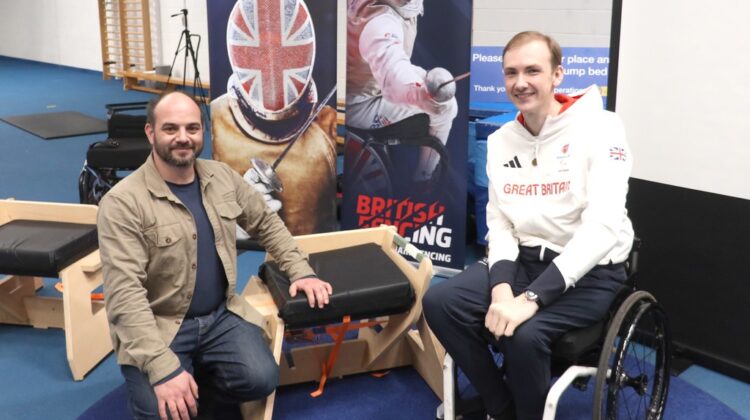
Engineers at the University of Bath, in collaboration with British Fencing, have designed an innovative wooden-frame chair described as a ‘gamechanger’ by wheelchair fencing Paralympic gold-medallists Dimitri Coutya and Piers Gilliver.
The SwordSeat – a simple six-piece slot-together design that can be built from about £150 worth of plywood using minimal tools – is designed to make wheelchair fencing affordable and accessible to many more clubs and participants.
It recently received its official launch during an event hosted by British Fencing at the Team Bath Sports Training Village, home to the Wheelchair Fencing National Training Centre. Two-time Paris 2024 champion Coutya and Tokyo 2020 gold-medallist Gilliver (pictured above, at right) – who both train at the venue – were among the guests treated to a demonstration of the SwordSeat in action.
‘The SwordSeat is a fantastic innovation,’ said Gilliver. ’Wheelchair fencing frames are quite hard to source and the whole set-up can cost between £8,000 and £15,000. Something like this, which can be made with a simple piece of plywood and produced so cheaply, means more clubs can be welcoming to wheelchair fencers.’
‘The SwordSeat is a fantastic way to remove some of the barriers to the sport,’ added Coutya. ‘Equipment becomes much less of a problem and everyone now has the option to try wheelchair fencing.’
Before the demonstration, guests learned more about the work that had gone into the SwordSeat’s design and production from British Fencing inclusion officer (disability) Rick Rodgers, who initiated the project, and Ed Elias (pictured above, at left), a senior lecturer in the university’s Department of Mechanical Engineering, who created the SwordSeat with integrated design engineering student, Conor Roberts.
‘We wanted to try to get the set-up costs down to as low as we could,’ said Elias. ‘We’ve made an Ikea-style slot-together piece of equipment that can be built with home DIY tools. We’re really excited that it is going to open up wheelchair fencing to many more people.’
Only a handful of the UK’s 400+ fencing clubs currently have wheelchair-fencing rigs, which cost more than £5,000 and need to have wheelchairs attached, totalling more than £15,000. They are also bulky and require lots of storage space.
By contrast, the SwordSeat’s six parts can be cut from a single piece of 25-millimetre plywood board and the only tools required are a jigsaw (or handsaw) and a six-millimetre drill. Once cut, the parts can be assembled in around one minute and strapped together with ratchet straps for vital rigidity, or taken apart and flat-packed for easy transport.
The seat also incorporates an alignment board that can be configured to accommodate any combination of right- or left-handed competitors. The DIY nature of the design means that changing some elements is possible, such as increasing the height of seat backs to help users with spinal injuries who may need additional support, and damaged parts can be easily replaced.
Expressions of interest in a SwordSeat can be made through the British Fencing website.


